International Journal of Image, Graphics and Signal Processing @ijigsp
Статьи журнала - International Journal of Image, Graphics and Signal Processing
Все статьи: 1157
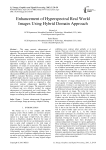
Enhancement of Hyperspectral Real World Images Using Hybrid Domain Approach
Статья научная
This paper presents enhancement of hyperspectral real world images using hybrid domain approach. The proposed method consists of three phases: In first phase the discrete wavelet transform is applied and approximation coefficient is selected. In second phase approximation coefficient of discrete wavelet transform of image is process by automatic contrast adjustment technique and in third phase it takes logarithmic of output of second phase and after that adaptive filtering is applied for image enhancement in frequency domain. To judge the superiority of proposed method the image quality parameters such as measure of enhancement (EME) and measure of enhancement factor (EMF) is evaluated. Therefore, a better value of EME and EMF implies that the visual quality of the enhanced image is good. Simulation results indicates that proposed method provides better results as compared to other state-of-art contrast enhancement algorithms for hyperspectral real world images. The proposed method is efficient and very effective method for contrast enhancement of hyperspectral real world images. This method can also be used in different applications where images are suffering from different contrast problems.
Бесплатно
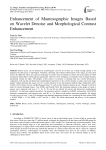
Enhancement of Mammographic Images Based on Wavelet Denoise and Morphological Contrast Enhancement
Статья научная
Breast cancer can be detected by mammograms, but not all of them are of high enough quality to be diagnosed by physicians or radiologists. Therefore, denoising and contrast enhancement in the image are issues that need to be addressed. There are numerous techniques to reduce noise and enhance contrast; the most popular of which incorporate spatial filters and histogram equalization. However, these techniques occasionally result in image blurring, particularly around the edges. The purpose of this article is to propose a technique that uses wavelet denoising in conjunction with top-hat and bottom-hat morphological transforms in the wavelet domain to reduce noise and image quality without distorting the image. Use five wavelet functions to test the proposed method: Haar, Daubechies (db3), Coiflet (coif3), Symlet (sym3), and Biorthogonal (bior1.3); each wavelet function employs levels 1 through 4 with four types of wavelet shrinkage: Bayer, Visu, SURE, and Normal. Three flat structuring elements in the shapes of a disk, a square, and a diamond with sizes 2, 5, 10, 15, 20, and 30 are utilized for top-hat and bottom-hat morphological transforms. To determine optimal parameters, the proposed method is applied to mdb001 mammogram (mini MIAS database) contaminated with Gaussian noise with SD, = 20. Based on the quality assessment quantities, the Symlet wavelet (sym3) at level 3, with Visu shrinkage and diamond structuring element size 5 produced the best results (MSE = 50.020, PSNR = 31.140, SSIM = 0.407, and SC = 1.008). The results demonstrate the efficacy of the proposed method.
Бесплатно
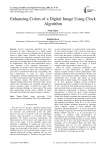
Enhancing Colors of a Digital Image Using Clock Algorithm
Статья научная
Several commercial algorithms have been developed for color enhancement of a digital image; however, none of these are completely able to preciously process a digital image. Therefore, this article focuses upon pixel-by-pixel processing, especially in the field of color enhancement of digital image. The enhancement is performed on individual pixel by taking information from its neighborhood. This has been implemented using a clock algorithm. Clock algorithm enhancement is implemented on human visual system based hexagonal sampled pixels instead of square ones. Enhancement of each pixel is performed both locally and globally. The local enhancement is done by using wavelet normalization. It obtains different bands of information as it enables localizing the signal information both in time and frequency domain. The global enhancement is obtained through Gabor filter. The Gabor filter extracts region based information and combined information is used to recognize region of interest also Gabor filter justifies biological findings in vision system. The results after enhancement provide better visibility of minor information and finally the enhanced image is obtained.
Бесплатно
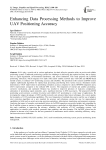
Enhancing Data Processing Methods to Improve UAV Positioning Accuracy
Статья научная
UAVs play a crucial role in various applications, but their effective operation relies on precise and reliable positioning systems. Traditional positioning systems face challenges in delivering the required accuracy due to factors such as signal degradation, environmental interference, and sensor limitations. This study proposes the LeGNSS positioning subsystem, which integrates low Earth orbit (LEO) satellite network data with GPS and MEMS-based inertial systems, to enhance UAV positioning accuracy and reliability. The presented in this research LeGNSS system employs sophisticated algorithms for optimal data processing and filtering from various sources. Simulation results demonstrate a 9.02% improvement in positioning estimation accuracy compared to classic GPS/INS integration and a 26.4% improvement compared to the onboard GPS receiver. The integration of inertial and satellite positioning, corrective mechanisms, and optimized filtration has resulted in improved precision of trajectory computations, attenuation of positioning signal anomalies, and a significant decrease in INS inaccuracies. The proposed LeGNSS positioning system presents a solution for precise and reliable UAV positioning in a wide range of applications. By leveraging the unique advantages of LEO satellite networks and advanced data fusion techniques, this system pushes the boundaries of UAV positioning capabilities. The novel integration of multiple data sources and the use of adaptive error correction algorithms set a new standard for accuracy and robustness, paving the way for unprecedented capabilities in fields such as aerial surveying, precision agriculture, infrastructure monitoring, and emergency response. Analysing the impact of complex environmental factors on LeGNSS operation can provide insights into expanding the list of satellite systems or sensors to improve positioning accuracy, particularly in high-latitude regions. The findings of this study contribute to improving the accuracy, reliability, and resilience of UAV positioning systems, with applications in scientific polar research, geomatics data gathering, and other domains. The LeGNSS system has the potential to become a key feature for the next generation of autonomous aerial vehicles, unlocking efficiency, safety, and innovation across industries.
Бесплатно
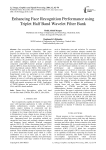
Enhancing Face Recognition Performance using Triplet Half Band Wavelet Filter Bank
Статья научная
Face recognition using subspace methods are quite popular in research community. This paper proposes an efficient face recognition method based on the application of recently developed triplet half band wavelet filter bank (TWFB) as pre-processing step to further enhance the performance of well known linear and nonlinear subspace methods such as principle component analysis(PCA),kernel principle component analysis (KPCA), linear discriminant analysis (LDA), and kernel discriminant analysis (KDA). The design of 6th order TWFB is used as the multiresolution analysis tool to perform the 2-D discrete wavelet transform (DWT). Experimental results are performed on two standard databases ORL and Yale. Comparative results are obtained in terms of verification performance parameters such as false acceptance rate (FAR), false rejection rate (FRR) and genuine acceptance rate (GAR). Application of TWFB enhances the performance of PCA, KPCA, LDA, and KDA based methods.
Бесплатно
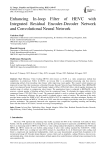
Статья научная
High Efficiency Video Coding (HEVC) often known as H.265 is a video compression method that outperforms its predecessor H.264. In HEVC, an in-loop filter is an additional processing step that removes compressing artifacts from decoding video frames while improving visual quality. This research article proposes an improved in-loop filter that incorporates a Residual Encoder-Decoder Network based Deblocking Filter (REDNetDF) and a Convolutional Neural Network based Sample Adaptive Offset (CNN-SAO) filter, which together eliminates the smallest range of artifacts in compression video frames. The quantization frame is subjected to REDNetDF, which removes a minute number of blocking artifacts from the compressed frame. To eliminate the ringing artifacts in the compressed frame, CNN-SAO filter is used. The proposed method is used to evaluate the publicly available UVG dataset. To demonstrate efficiency, the new model is evaluated using a variety of metrics. The outcome of this study provides better results like PSNR of 49.7 dB and the SSIM of 0.97 in comparison with other techniques. Besides, the model's outcome indicates an MSE of 1.8 and saves 24.9% more bits on average to provide the same level of quality as previous techniques. The proposed framework also suppresses time complexities regarding encoding and decoding times with the results of 90.5 and 4.5 seconds on average correspondingly.
Бесплатно
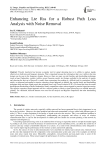
Enhancing Lte Rss for a Robust Path Loss Analysis with Noise Removal
Статья научная
Wavelet transform has become a popular tool for signal denoising due to its ability to analyze signals effectively in both time and frequency domains. This is important because the information that is not visible in the time domain can be seen in the frequency domain. However, there are many wavelet families and thresholding techniques (such as haar, Daubechies, symlets, coiflets, meyer Gaussian, morlet, etc) thatare available for the analysis of signals, and choosing the best out of them all is usually time-consuming, thus making it a difficult task for researchers. In this article, we proposed and applied a stepwise expository-based approach to identify the wavelet family and thresholding technique using real-time signal power data acquired from Long-Term Evolution (LTE). We found out from the results that Rigrsure thresholding with the Daubenchies family outperforms others when engaged in practical signal processing. The stepwise expository-based approach will be a relevant guide to effective signal processing over cellular networks, globally. For validation, different datasets were used for the analysis and Rigrsure outperforms the other thresholding techniques.
Бесплатно
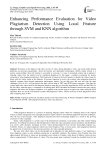
Статья научная
Nowadays in the digital world, there are lots of videos being uploaded to video, and social media sharing platforms are growing exponentially. About the Internet and multimedia technologies, illicitly copied content is a serious social problem. Since the internet is accessible to everyone, it is easy to download content and re-upload it. Copying videos from the internet can be considered plagiarism. In this paper, a method is proposed for feature extraction of video plagiarism detection. This framework is based on the local features to identify the videos frame by frame with the videos stored in the database. It becomes important to review the existing video plagiarism detection methods, compare them through appropriate performance metrics, list out their pros and cons and state the open challenges. First of all, it will pre-process the data with the help of SIFT and OCR Feature extraction. After that, the system applies the video retrieval and detection function using the two classifier algorithm the SVM, and the KNN. In the first stage, when the query is compared to all training data, KNN calculates the distances between the query and its neighbors and selects the K nearest neighbors. It is applied in the second stage to recognize the object using the SVM algorithm. Here we use the VSD dataset to predict the plagiarized videos. And the accuracy of these plagiarized videos after comparing them is 98%.
Бесплатно
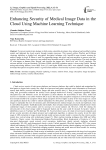
Enhancing Security of Medical Image Data in the Cloud Using Machine Learning Technique
Статья научная
To prevent medical data leakage to third parties, algorithm developers have enhanced and modified existing models and tightened the cloud security through complex processes. This research utilizes PlayFair and K-Means clustering algorithm as double-level encryption/ decryption technique with ArnoldCat maps towards securing the medical images in cloud. K-Means is used for segmenting images into pixels and auto-encoders to remove noise (de-noising); the Random Forest regressor, tree-method based ensemble model is used for classification. The study obtained CT scan-images as datasets from ‘Kaggle’ and classifies the images into ‘Non-Covid’ and ‘Covid’ categories. The software utilized is Jupyter-Notebook, in Python. PSNR with MSE evaluation metrics is done using Python. Through testing-and-training datasets, lower MSE score (‘0’) and higher PSNR score (60%) were obtained, stating that, the developed decryption/ encryption model is a good fit that enhances cloud security to preserve digital medical images.
Бесплатно
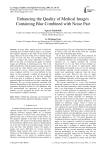
Enhancing the Quality of Medical Images Containing Blur Combined with Noise Pair
Статья научная
In many fields, images become a useful tool containing data of which medical image is an example. The diagnosis depends on the skills of the doctors and image clarity. In the real world, most of medical images consist of noise and blur. This problem reduces the quality of images and causes difficulties for doctors. Most of the tasks of increasing the quality of medical images are deblurring or denoising process. This is the difficult problem in medical image processing, because it must keep the edge features and avoid the loss of information. In case of a medical image which contains noise combined with blur, it is more difficult. In this paper, we have proposed a method for increasing the quality of medical images in case that blur combined with noise pair is available in medical images. The proposed method is divided into two steps: denoising and deblurring. We use curvelet transform combined with bayesian thresholding for the denoising step and use the augmented lagrangian method for the deblurring step. For demonstrating the superiority of the proposed method, we have compared the results with the other recent methods available in literature.
Бесплатно
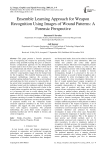
Статья научная
This paper presents a forensic perspective way of recognizing the weapons by processing wound patterns using ensemble learning that gives an effective forensic computational approach for the distinguished weapons used in most of crime cases. This will be one of the computational and effective substitutes to investigate the weapons used in crime, the methodology uses the collective wound patterns images from the human body for the recognition. The ensemble learning used in this proposed methodology improves the accuracy of machine learning methods by combining several methods and predicting the final accuracy by meta-classifier. It has given better recognition process compared to single individual model and the traditional method. Ensemble learning is more flexible in function and is better in the wound pattern recognition and their respective weapons as it overcomes the issue to overfit training data. The result achieved for weapon recognition based on wound patterns is 98.34%, from existing database of 800 images of pattern consisting of wounds of stabbed and gunshots. The authenticated experiments out-turns the preeminence of projected method over the widespread feature extraction approach considered in the work and also compares and suggest the false positive recognition verses false negative recognition. The proposed methodology has given better results compared to traditional method and will be helpful in forensic and crime investigation.
Бесплатно
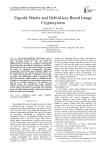
Ergodic Matrix and Hybrid-key Based Image Cryptosystem
Статья научная
The existing traditional cryptosystems, such as RSA, DES, IDEA, SAFER and FEAL, are not ideal for image encryption because of their slow speed and ineffectiveness in removing the correlations of the adjacent pixels. Meanwhile chaos-based cryptosystems, which have been extensively used over the past two decades, are almost all based on symmetric cryptography. Symmetric cryptography is much faster than asymmetric ciphers, but the requirements for key exchange make them hard to use. To remedy this imperfection, a hybrid-key based image encryption and authentication scheme is proposed in this paper. In particular, ergodic matrices are utilized not only as public keys throughout the encryption/decryption process, but also as essential parameters in the confusion and diffusion stages. The experimental results, statistical analysis and sensitivity-based tests confirm that, compared to the existing chaos-based cryptosystems, the proposed image encryption scheme provides a more secure means of image encryption and transmission.
Бесплатно
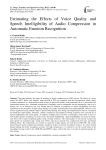
Статья научная
This paper projects, the impact & accuracy of speech compression on AER systems. The effects of various codecs like MP3, Speex, and Adaptive multi-rate(NB & WB) are compared with the uncompressed speech signal. Loudness enlistment, or a steeper-than-normal increase in perceived loudness with presentation level, is associated with sensorineural hearing loss. Amplitude compression is frequently used to compensate for this abnormality, such as in a hearing aid. As an alternative, one may enlarge these by methods of expansion as speech intelligibility has been represented as the perception of rapid energy changes, may make communication more understandable. However, even if these signal-processing methods improve speech understanding, their design and implementation may be constrained by insufficient sound quality. Therefore, syllabic compression and temporal envelope expansion were assessed for in speech intelligibility and sound quality. An adaptive technique based on brief, commonplace words either in noise or with another speaker competing was used to assess the speech intelligibility. Speech intelligibility was tested in steady-state noise with a single competing speaker using everyday sentences. The sound quality of four artistic excerpts and quiet speech was evaluated using a rating scale. With a state-of-art, spectral error, compression error ratio, and human labeling effects, The experiments are carried out using the Telugu dataset and well-known EMO-DB. The results showed that all speech compression techniques resulted in reduce of emotion recognition accuracy. It is observed that human labeling has better recognition accuracy. For high compression, it is advised to use the overall mean of the unweighted average recall for the AMR-WB and SPEEX codecs with 6.6 bit rates to provide the optimum quality for data storage.
Бесплатно
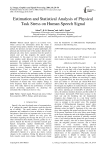
Estimation and Statistical Analysis of Physical Task Stress on Human Speech Signal
Статья научная
Human speech signal is an acoustic wave, which conveys the information about the words or message being spoken, identity of the speaker, language spoken, the presence and type of speech pathologies, the physical and emotional state of the speaker. Speech under physical task stress shows variations from the speech in neutral state and thus degrades the speech system performance. In this paper we have characterized the voice samples under physical stress and the acoustic parameters are compared with the neutral state voice parameters. The traditional voice measures, glottal flow parameters, mel frequency cepstrum coefficients and energy in various frequency bands are used for this characterization. T-test is performed to check the statistical significance of parameters. Significant variations are noticed in the parameters under two states. Pitch, intensity, energy values are high for the physically stressed voice; On the other hand glottal parameter values get decreased. Cepstrum coefficients shift up from the coefficients of neutral state voice samples. Energy in lower frequency bands was more sensitive to physical stress. This study improves the performance of various speech processing applications by analyzing the unwanted effect of physical stress in voice.
Бесплатно
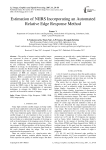
Estimation of NIIRS incorporating an automated relative edge response method
Статья научная
The quality of remote sensing satellite images are expressed in terms of ground sample distance, modular transfer function, signal to noise ratio and National Imagery Interpretability Rating Scale (NIIRS) by user community. The proposed system estimates NIIRS of an image, by incorporating a new automated method to calculate the Relative Edge Response (RER). The prominent edges which contribute the most for the estimation of RER are uniquely extracted with a combined application of certain filters and morphological operators. RER is calculated from both horizontal and vertical edges separately and the geometric mean is considered as the final result. Later applying the estimated RER along with other parameters, the system returns the NIIRS value of the input image. This work has proved the possible implementation of automated techniques to estimate the NIIRS from images and specifics in the metafile contents of imagery.
Бесплатно
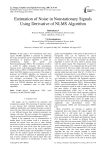
Estimation of Noise in Nonstationary Signals Using Derivative of NLMS Algorithm
Статья научная
In this paper a new Normalized Least mean square (NLMS) algorithm is proposed by modifying Error-data normalized step-size algorithm (EDNSS). The performance of proposed algorithm is tested for nonstationary signals like speech and Electroencephalogram (EEG). The simulations of above is carried by adding stationary and nonstationary Gaussian noise , with original speech taken from standard IEEE sentence (SP23) of NOIZEUS data base and EEG taken from EEG database (sccn.ucsd.edu). The output of proposed and EDNSS algorithm are measured with excess mean square error (EMSE) in both stationary and non stationary environment. The results can be appreciated that the proposed algorithm gives improved result over EDNSS algorithm and also the speed of convergence is maintained same as other NLMS algorithms.
Бесплатно
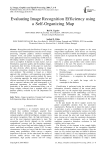
Evaluating Image Recognition Efficiency using a Self-Organizing Map
Статья научная
Recognition and classification of images is an extremely topical interdisciplinary area that covers image processing, computer graphics, artificial intelligence, computer vision, and pattern recognition, resulting in many applications based on contemporary mobile devices. Developing reliable recognition schemes is a difficult task to accomplish. It depends on many factors, such as illumination, acquisition quality and the database images, in particular, their diversity. In this paper we study how the data diversity affects decision making in image recognition, presenting a database driven classification-error predictor. The predictor is based on a hybrid approach that combines a self-organizing map together with a probabilistic logical assertion method. By means of a clustering approach, the model provides fast and efficient assessment of the image database heterogeneity and, as expected, indicates that such heterogeneity is of paramount importance for robust recognition. The practicality of the model is demonstrated using a set of image samples collected from a standard traffic sign database publicly available by the UK Department for Transport.
Бесплатно
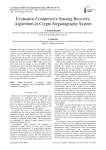
Evaluation Compressive Sensing Recovery Algorithms in Crypto Steganography System
Статья научная
The main contribution of this paper is using compressive sensing (CS) theory for crypto steganography system to increase both the security and the capacity and preserve the cover image imperceptibility. For CS implementation, the discrete Cosine transform (DCT) as sparse domain and random sensing matrix as measurement domain are used. We consider 7 MRI images as the secret and 7 gray scale test images as cover. In addition, three sampling rates for CS are used. The performance of seven CS recovery algorithms in terms of image imperceptibility, achieved peak signal to noise ratio (PSNR), and the computation time are compared with other references. We showed that the proposed crypto steganography system based on CS works properly even though the secret image size is greater than the cover image.
Бесплатно
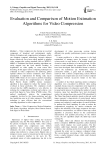
Evaluation and Comparison of Motion Estimation Algorithms for Video Compression
Статья научная
Video compression has become an essential component of broadcast and entertainment media. Motion Estimation and compensation techniques, which can eliminate temporal redundancy between adjacent frames effectively, have been widely applied to popular video compression coding standards such as MPEG-2, MPEG-4. Traditional fast block matching algorithms are easily trapped into the local minima resulting in degradation on video quality to some extent after decoding. In this paper various computing techniques are evaluated in video compression for achieving global optimal solution for motion estimation. Zero motion prejudgment is implemented for finding static macro blocks (MB) which do not need to perform remaining search thus reduces the computational cost. Adaptive Rood Pattern Search (ARPS) motion estimation algorithm is also adapted to reduce the motion vector overhead in frame prediction. The simulation results showed that the ARPS algorithm is very effective in reducing the computations overhead and achieves very good Peak Signal to Noise Ratio (PSNR) values. This method significantly reduces the computational complexity involved in the frame prediction and also least prediction error in all video sequences. Thus ARPS technique is more efficient than the conventional searching algorithms in video compression.
Бесплатно
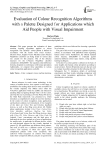
Статья научная
This paper presents the evaluation of three machine learning algorithms applied to colour recognition. The “primary” colour palette is defined in accordance with the results from social sciences. Decision Trees, Support Vector Machines and k-Nearest Neighbours classifiers are being tested on various data sets created for this purpose. One of the distance measures for the k-Nearest Neighbour classifier considered is DeltaE2000 - the standard colour difference formula, designed in conformance with human perception. Additionally, we compare these algorithms to various colour recognition applications available.
Бесплатно

